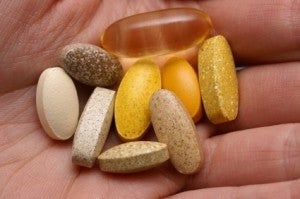Vitamins and Minerals

Vitamins and minerals are micronutrients required by the body to carry out a range of normal functions. However, these micronutrients are not produced in our bodies and must be derived from the food we eat.
Vitamins are organic substances that are generally classified as either fat soluble or water soluble. Fat-soluble vitamins (vitamin A, vitamin D, vitamin E, and vitamin K) dissolve in fat and tend to accumulate in the body. Water-soluble vitamins (vitamin C and the B-complex vitamins, such as vitamin B6, vitamin B12, and folate) must dissolve in water before they can be absorbed by the body, and therefore cannot be stored. Any water-soluble vitamins unused by the body is primarily lost through urine.
Minerals are inorganic elements present in soil and water, which are absorbed by plants or consumed by animals. While you’re likely familiar with calcium, sodium, and potassium, there is a range of other minerals, including trace minerals (e.g. copper, iodine, and zinc) needed in very small amounts.
In the U.S., the National Academy of Medicine (formerly the Institute of Medicine) develops nutrient reference values called the Dietary Reference Intakes (DRIs) for vitamins and minerals. [1] These are intended as a guide for good nutrition and as a scientific basis for the development of food guidelines in both the U.S. and Canada. The DRIs are specific to age, gender, and life stages, and cover more than 40 nutrient substances. The guidelines are based on available reports of deficiency and toxicity of each nutrient. Learn more about vitamins and minerals and their recommended intakes in the table below.
Recommended Daily Intake of Vitamins and Minerals for Adults
| Vitamin (Common Names) | Recommended Dietary Allowance (RDA) or Daily Adequate Intake (AI)* | Upper Limit | |
| Women | Men | ||
| Vitamin A (preformed = retinol; beta-carotene can be converted to Vitamin A) | 700 micrograms (2,333 IU) | 900 micrograms (3,000 IU) | 3,000 micrograms (about 10,000 IU) |
| Thiamin (vitamin B1) | 1.1 milligrams | 1.2 milligrams | Not known |
| Riboflavin (vitamin B2) | 1.1 milligrams | 1.3 milligrams | Not known |
| Niacin (vitamin B3; nicotinic acid) | 14 milligrams | 16 milligrams | 35 milligrams |
| Pantothenic Acid (vitamin B5) | 5 milligrams* | 5 milligrams* | Not known |
| Vitamin B6 (pyridoxal, pyridoxine, pyridoxamine) | Ages 19-50: 1.3 milligrams
Ages 51+: 1.5 milligrams |
Ages 19-50: 1.3 milligrams
Ages 51+: 1.7 milligrams |
100 milligrams |
| Biotin (vitamin B7) | 30 micrograms* | 30 micrograms* | Not known |
| Folate (Folic acid; vitamin B9) | 400 micrograms | 400 micrograms | 1,000 micrograms |
| Vitamin B12 | 2.4 micrograms | 2.4 micrograms | Not known |
| Vitamin C | 75 milligrams*
(Smokers add 35 milligrams) |
90 milligrams*
(Smokers add 35 milligrams) |
2,000 milligrams |
| Choline | 425 milligrams* | 550 milligrams* | 3,500 milligrams |
| Vitamin D (calciferol) | Ages 19-50: 15 micrograms (600 IU)
Ages 51-70: 15 micrograms (600 IU) Ages 71+: 20 micrograms (800 IU) |
Ages 19-50: 15 micrograms (600 IU)
Ages 51-70: 15 micrograms (600 IU) Ages 71+: 20 micrograms (800 IU) |
100 micrograms (4,000 IU) |
| Vitamin E (alpha-tocopherol) | 15 milligrams | 15 milligrams | 1,000 milligrams |
| Vitamin K (phylloquinone, menadione) | 90 micrograms* | 120 micrograms* | Not known |
| Mineral | Recommended Dietary Allowance (RDA) or Daily Adequate Intake (AI)* | Upper Limit | |
| Women | Men | ||
| Calcium | Ages 31-50: 1,000 milligrams
Ages 51+: 1,200 milligrams |
Ages 31-50: 1,000 milligrams
Ages 51+: 1,200 milligrams |
2,500 milligrams |
| Chloride | Ages 19-50: 2.3 grams*
Ages 51-70: 2.0 grams* Ages 71+: 1.8 grams* |
Ages 19-50: 2.3 grams*
Ages 51-70: 2.0 grams* Ages 71+: 1.8 grams* |
Not known |
| Chromium | Ages 31-50: 25 micrograms*
Ages 51+: 20 micrograms* |
Ages 31-50: 35 micrograms*
Ages 51+: 30 micrograms* |
Not known |
| Copper | 900 micrograms | 900 micrograms | 10,000 micrograms |
| Fluoride | 3 milligrams | 4 milligrams | 10 milligrams |
| Iodine | 150 micrograms | 150 micrograms | 1,100 micrograms |
| Iron | Ages 31-50: 18 milligrams
Ages 51+: 8 milligrams |
Ages 31-50: 8 milligrams
Ages 51+: 8 milligrams |
45 milligrams |
| Magnesium | Ages 19-30: 310 milligrams
Ages 31-70+: 320 milligrams |
Ages 19-30: 400 milligrams
Ages 31-70+: 420 milligrams |
350 milligrams (from supplements) |
| Manganese | 1.8 milligrams* | 2.3 milligrams* | 11 milligrams |
| Molybdenum | 45 micrograms | 45 micrograms | 2,000 micrograms |
| Nickel | N/A** | N/A** | N/A** |
| Phosphorus | 700 milligrams | 700 milligrams | Ages 31-70: 4,000 milligrams
Ages 71+: 3,000 milligrams |
| Potassium | Ages 14-18: 2,300 milligrams*
Ages 19+: 2,600 milligrams* |
Ages 14-18: 3,000 milligrams*
Ages 19+: 3,400 milligrams* |
Not known |
| Selenium | 55 micrograms | 55 micrograms | 400 micrograms |
| Sodium | 1,500 milligrams* | 1,500 milligrams* | Not determined; however a chronic disease risk reduction intake has been established |
| Zinc | 8 milligrams | 11 milligrams | 40 milligrams |
| * Denotes Adequate Intake (AI). An AI is
a recommended intake when an RDA can’t be determined. RDA is the
average daily dietary intake sufficient to meet the nutrient requirement
of 97-98% of healthy individuals in a particular group according to
stage of life and gender. ** May play a role in the human body, but adequate research regarding its nutritional importance is not available so RDA or AI has not been set. |
|||
 What about multivitamins?
What about multivitamins?
A diet that includes plenty of fruits, vegetables, whole grains, good protein packages, and healthful fats should provide most of the nutrients needed for good health. But not everyone manages to eat a healthful diet. Multivitamins can play an important role when nutritional requirements are not met through diet alone. Learn more about vitamin supplementation.
Did you know?
Vitamins and their precise requirements have been controversial since their discovery in the late 1800s and early 1900s. It was the combined efforts of epidemiologists, physicians, chemists, and physiologists that led to our modern day understanding of vitamins and minerals. After years of observation, experiments, and trial and error, they were able to distinguish that some diseases were not caused by infections or toxins—a common belief at the time—but by vitamin deficiencies. [2] Chemists worked to identify a vitamin’s chemical structure so it could be replicated. Soon after, researchers determined specific amounts of vitamins needed to avoid diseases of deficiency.
In 1912, biochemist Casimir Funk was the first to coin the term “vitamin” in a research publication that was accepted by the medical community, derived from “vita” meaning life, and “amine” referring to a nitrogenous substance essential for life. [3] Funk is considered the father of vitamin therapy, as he identified nutritional components that were missing in diseases of deficiency like scurvy (too little vitamin C), beri-beri (too little vitamin B1), pellagra (too little vitamin B3), and rickets (too little vitamin D). The discovery of all vitamins occurred by 1948.
Vitamins were obtained only from food until the 1930s when commercially made supplements of certain vitamins became available. The U.S government also began fortifying foods with specific nutrients to prevent deficiencies common at the time, such as adding iodine to salt to prevent goiter, and adding folic acid to grain products to reduce birth defects during pregnancy. In the 1950s, most vitamins and multivitamins were available for sale to the general public to prevent deficiencies, some receiving a good amount of marketing in popular magazines such as promoting cod liver oil containing vitamin D as bottled sunshine.
References
Last reviewed March 2023
Terms of Use
The contents of this website are for educational purposes and are not intended to offer personal medical advice. You should seek the advice of your physician or other qualified health provider with any questions you may have regarding a medical condition. Never disregard professional medical advice or delay in seeking it because of something you have read on this website. The Nutrition Source does not recommend or endorse any products.
Create healthy, balanced meals using this visual guide as a blueprint.
Support The Nutrition Source
Thank you for supporting our mission of translating food and nutrition knowledge into daily practice!




No comments:
Post a Comment